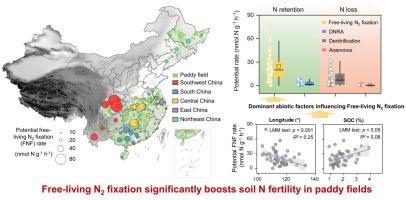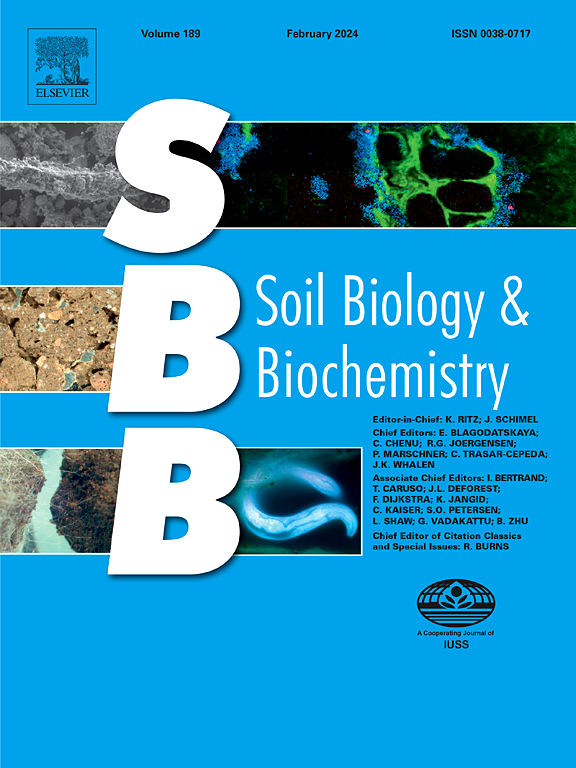Investigating drivers of free-living diazotroph activity in paddy soils across China
IF 10.3
1区 农林科学
Q1 SOIL SCIENCE
引用次数: 0
Abstract
Microbially mediated N fixation is widespread in rice paddy ecosystems and crucial in maintaining soil fertility. However, our understanding of the factors determining the distribution of free-living diazotrophic microorganisms that perform this process in paddy fields is limited. This study investigated the spatial distribution and factors influencing presence and potential activity of free-living microorganisms capable of N2 fixation in addition to dissimilatory nitrate reduction to ammonium (DNRA), anaerobic ammonium oxidation (anammox), and denitrification in 50 paddy soils across China. Using 15N isotope tracing in laboratory incubations and microbial community analysis via metagenomics, we demonstrate that paddy soils may represent a previously underappreciated hotspot for N2 fixation with mean potential rates of 24.4 ± 17.8 nmol N g−1 h−1, 10-fold higher than DNRA (2.55 ± 0.4 nmol N g−1 h−1), and could counterbalance a portion of N2 losses through anammox and denitrification (9.24 ± 1.1 nmol N g−1 h−1). Site longitude and organic carbon (C) concentrations, as well as the diazotrophic community composition, were the dominant abiotic and biotic factors accounting for regional variations in potential N2 fixation rates. The N2 metabolic pathways predicted from the metagenome-assembled genomes (MAGs) revealed significant co-occurrence of the diazotroph marker gene nifH with denitrification-associated genes (nirS/K and nosZ) and organic C oxidation-related genes (yiaY and galM). Furthermore, enzymes involved in organic C oxidation, particularly glycoside hydrolases and glycosyltransferases, were not only phenotypically correlated with free-living N2 fixation rates but were also identified in nifH-containing MAGs, indicating the heterotrophic capabilities of diazotrophs in paddy soils. Collectively, our results underscore the substantial contribution of free-living N2 fixation to soil N fertility in paddy fields, and highlight the importance of coupling organic C oxidation with nitrate reduction to enhance N2 fixation.

调查中国各地水稻田土壤中自由重氮营养体活动的驱动因素
微生物介导的氮固定在水稻田生态系统中非常普遍,对保持土壤肥力至关重要。然而,我们对决定水稻田中执行这一过程的自由生活重氮微生物分布的因素了解有限。本研究调查了中国 50 块水稻田土壤中除异氨硝酸盐还原(DNRA)、厌氧氨氧化(anammox)和反硝化作用外,还能固定 N2 的自由生活微生物的空间分布及其存在和潜在活性的影响因素。利用实验室培养的 15N 同位素追踪和元基因组学的微生物群落分析,我们证明水稻田土壤可能是以前未被充分重视的 N2 固定热点,其平均潜在速率为 24.4 ± 17.8 nmol N g-1 h-1,比 DNRA(2.55 ± 0.4 nmol N g-1 h-1)高 10 倍,并可抵消通过厌氧氧化和反硝化(9.24 ± 1.1 nmol N g-1 h-1)损失的部分 N2。地点的经度和有机碳(C)浓度以及重氮营养群落组成是造成潜在 N2 固定率区域差异的主要非生物和生物因素。根据元基因组组装基因组(MAGs)预测的 N2 代谢途径显示,重氮营养体标记基因 nifH 与反硝化相关基因(nirS/K 和 nosZ)和有机碳氧化相关基因(yiaY 和 galM)显著共存。此外,参与有机碳氧化的酶,特别是糖苷水解酶和糖基转移酶,不仅在表型上与自由生活的 N2 固定率相关,而且在含 nifH 的 MAGs 中也被鉴定出来,这表明稻田土壤中重氮营养体具有异养能力。总之,我们的研究结果强调了自由生活的氮固定对稻田土壤氮肥的巨大贡献,并突出了将有机碳氧化与硝酸盐还原结合起来以提高氮固定的重要性。
本文章由计算机程序翻译,如有差异,请以英文原文为准。
求助全文
约1分钟内获得全文
求助全文
来源期刊

Soil Biology & Biochemistry
农林科学-土壤科学
CiteScore
16.90
自引率
9.30%
发文量
312
审稿时长
49 days
期刊介绍:
Soil Biology & Biochemistry publishes original research articles of international significance focusing on biological processes in soil and their applications to soil and environmental quality. Major topics include the ecology and biochemical processes of soil organisms, their effects on the environment, and interactions with plants. The journal also welcomes state-of-the-art reviews and discussions on contemporary research in soil biology and biochemistry.
 求助内容:
求助内容: 应助结果提醒方式:
应助结果提醒方式:


